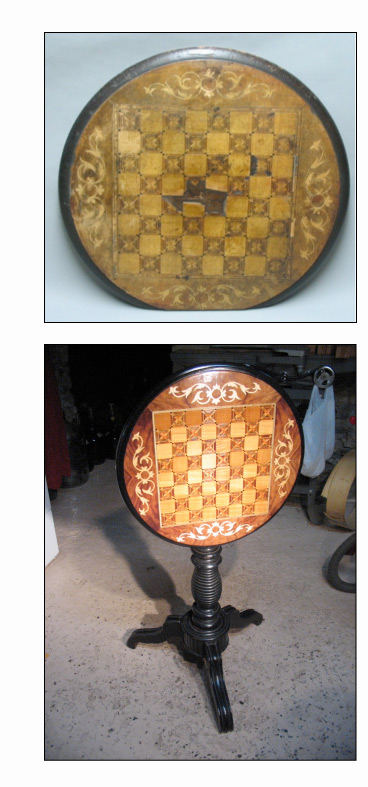John Sedgwick
Marquetry and Inlay Restoration
Grimsby Ontario
Do you have a treasured piece of furniture, box etc, that has damaged Marquetry/inlay and your best efforts to find someone to restore it to its original condition have so far failed?
That piece of history - perhaps your history, I know would welcome the opportunity to show its self again in a place of pride within your home. Contact me - Let's talk.

In times when furniture was made to outlast their owners, the wood working skills were very different than today. Fashion trends change and alternate about every 10 or so years, No doubt inspired by the many Furniture retailers. Longevity is not a major consideration in today's purchasing world;
For a period Walnut is too dark; which is then replaced with "Maple" which is then too light, and replaced with "Cherry and Oak" which is replaced by Mahogany and eventually back to Walnut . What is too ornate is then simplified, that which was wood is now glass steel or marble. These changing fashion trends are not new, what is new is how quickly they change.
In garages, crawl spaces, attics and storage facilities are peoples prized antique furniture pieces, which like orphans, are looking for their parents and the skills to restore them.
Why is this? When to replace it with a functional piece of furniture is simple, it is because "QUALITY" never goes out of style "look alike" and "Faux" preceding any description of furniture pays respect to a time when quality as well as fashion was expected not an option. For most people "Marquetry" the assembling of multiple veneers to form a pictorial design and "Parquetry" the assembling of geometric shapes to make a repeating design is a mystery. "How do you get those pieces of veneer to fit so tightly" I am typically asked, my reply usually is "very carefully". These techniques are not for the weekend warrior to take a stab at with the help of the local DIY store. It takes time and a lot of practice, as does most things of value.
What I have also learned is that old does not signify quality workmanship it just means that it is old. To have a link to the past is all that is important for some, who are satisfied to litter their homes with furniture rescued from Chicken coops or barns. (This Week) Like Barn Board and the barns from which they came --- this too will pass.
The period which I shall refer to as "Early Chicken Coop" is not furniture likely to have seen any quality workmanship or any marquetry to be repaired and not the furniture which I restore.
When I begin the process of restoration there is a conversation I have with the piece, who was it made for originally? What were the steps that let to this design? Like the Wood Turner or Carver (As a matter of interest, the origin of those Surnames) the Marquetrian would not typically have been totally responsible for the furniture decoration design. They would typically have been given the size, shape, and dimensions of the areas to be covered and a sketch with a rough idea as to what was required along with an assortment of veneers choices which could be used. Unless there was a one of a kind request where an artist would provide a picture and design, frequently used patterns were scaled to fit the proposed areas. Knowing the process I enjoy finding the hidden marks left by the makers. Making thenecessary drawings and calculations and resolving the project issues while following the same winding path they had done in conceiving and making the piece.
Unless you visit a museum or stately homes of Europe and restored Mansions in big cities of the USA you may never have seen such pieces in their original or restored condition and for many these pieces are a relic which does not exactly fit with today's more functional furniture.
Above is a pedestal tilt table decorated as an elaborate chess table. Although the pedestal required refinishing the round table top was missing an edge most probably the result of cross grain board separation. The shellac finish showed the accumulation of years of waxing, as well as the loss of pieces of veneer due to the deterioration of the hide glue exposure to the air.
Examples of other restorations, such as music boxes can be seen in the furniture galleries. Not exactly as functional as an "I-Pod" but capable of playing multiple musical tunes for many hours. These boxes are powered using a crank wound heavy spring which then slowly turns 3"-4"brass cylinders festooned with pins which strike a tuned steel comb, by exchanging the brass drums many hours classical favorites would fill the room - a mechanical wonder of the age.